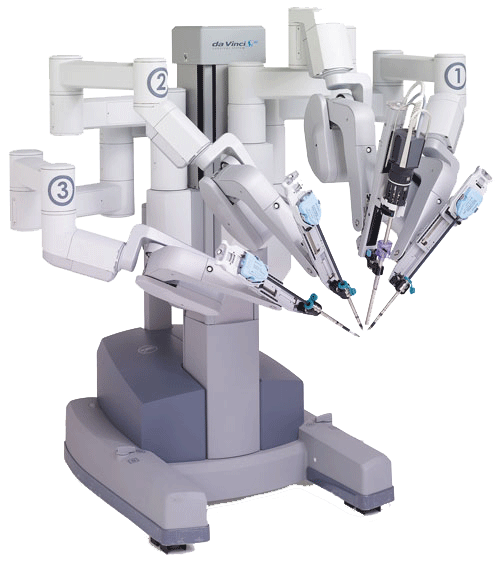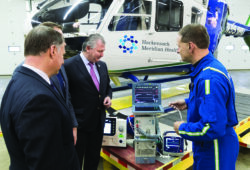The field of robotics has moved from the realm of sci-fi thriller to the leading edge of healthcare advancement. Since the da Vinci Surgical System was approved by the Food and Drug Administration (FDA) for general laparoscopic surgery in 2000, robotics technology has evolved rapidly. Robotics are now used in certain operations and to screen for diseases. For certain indications, robotics exhibit remarkable results in patients’ recovery from surgery and in patient satisfaction. Despite the advances, however, it’s important for the supply chain to consider the potential advantages and disadvantages of investing in such technology.
Randy Fagin, M.D., vice president of robotic surgery at Hospital Corporation of America (HCA), explains some of the reasons why robotics is an area of growth for its hospitals and a promising avenue for improving patient care outcomes.
The da Vinci’s Dominance
Today, Intuitive Surgical’s da Vinci Surgical System is used in four out of five radical prostatectomies performed in the United States, and it is also widely used in hysterectomies.
The system’s console and robot arms are designed to help surgeons make small, minimally invasive incisions, and operate with enhanced visualization, dexterity, precision and comfort. A surgeon sits at a workstation behind a monitor and looks at a magnified view of the surgical site while operating the machine’s robotic arms.
“Robotics … allows more patients to receive the benefits of minimally invasive surgery, such as a shorter length of stay and a more rapid return to their lives.”
— Randy Fagin, M.D., HCA’s vice president of robotic surgery
The remote-controlled instruments are inserted into a patient through small incisions. These robotic arms can get into hard-to-reach places in a patient’s body, which can reduce bleeding and lower the chance of nerve damage. Robotic surgery can also mean the patient recovers faster, with smaller scars than in traditional surgeries.
“Robotics is an enabling technology that allows more patients to receive the benefits of minimally invasive surgery, such as a shorter length of stay and a more rapid return to their lives,” Fagin says. “The ability to shift more cases to minimally invasive means you’re able to achieve higher mean and median outcomes.”
However, it’s an expensive system—the average cost ranges between $1.5 and $2 million, due in part, some say, to lack of competition in the market. And although robotic surgery allows more patients to undergo minimally invasive surgery, there isn’t as yet sufficient evidence that robotic surgery offers better outcomes than some traditional laparoscopic surgeries. Taken together, these factors make the decision to invest in robotic-assisted surgery a difficult one for many hospitals.
However, some physicians say the shortcomings are related to inadequate training and experience, not deficiencies in the technology. “There are no bad robots, there are just bad surgeons,” said W. Douglas Boyd, M.D., a professor of surgery at the University of California Davis Health System, in an October 23, 2014, article in The New York Times.
New Players Enter the Market
While Intuitive Surgical has long been the only major player in surgical robotics, new manufacturers are entering the market. Canadian company Titan Medical, employing technology developed at Columbia University and Vanderbilt University, and North Carolina-based Transenterix are both working on commercializing a single port robotic technology for laparoscopic surgery, allowing surgeons to operate via just one small incision. The Titan Surgical System has an expected U.S. commercial launch of mid-2017 and the Transenterix system potentially in early 2016.
Meanwhile, on the orthopedic side, the use of robotics is becoming more commonplace, thanks to systems such as MAKO Surgical’s surgeon-controlled RIO robotic arm interactive orthopedic system and Curexo Technology Corporation’s ROBODOC, both of which assist in partial knee resurfacing and total hip arthroplasty.
For spine surgeries, hospitals can utilize Mazor Robotics’ Renaissance System, which is currently the only company with an FDA-cleared surgical guidance system for spinal surgeries.
What all of these systems have in common is that none of them can act independently. There is no such thing as fully automated surgery—at least not yet. There have been many advances, but the field of surgical
robotics is still considered nascent.
A group of scientists at the University of California, Berkeley, with funding from the National Science Foundation, Intuitive Surgical and Google, is working to change that. Their Center for Automation and Learning for Medical Robotics is focusing on developing robots that can perform repetitive surgical subtasks such as suturing, cutting and debridement.
In another effort to advance the field, robotics engineers at the University of California–Santa Cruz and the University of Washington worked together to build a set of seven advanced robotic surgery systems, dubbed Raven-II, that use an open-source software platform. Five of these systems are in use by researchers at medical research laboratories at Harvard University, Johns Hopkins University, the University of Nebraska, Berkeley and UCLA.
HCA’s Investment in Robotics
Fagin, a board-certified urological surgeon and one of the nation’s most influential robotic surgery thought leaders, is working to leverage HCA’s robotics investment.
Fagin has a lot of (robotic) hands-on experience: Before his transition to HCA, he performed more than 3,000 robotic-assisted surgeries, trained surgeons from around the world and served as the senior medical advisor for Intuitive Surgical.
“The two biggest technical advantages of robotics surgery are improved vision and improved precision for surgeons,” Fagin says. “As a surgeon, if I can see it better, I can make better judgments in the operating room. If I have a more precise tool, then I have the opportunity to create less collateral damage. All of those things can result in the potential for improved outcomes and a more rapid recovery for our patients.”
 He compares advances in robotics to advances in auto technology: “New cars now have great features such as rear-view cameras to reduce the likelihood that I’m going to back into something. That doesn’t mean drivers are getting better. It just means technology is helping to reduce the likelihood of human error.
He compares advances in robotics to advances in auto technology: “New cars now have great features such as rear-view cameras to reduce the likelihood that I’m going to back into something. That doesn’t mean drivers are getting better. It just means technology is helping to reduce the likelihood of human error.
“In the same way, robotics doesn’t prevent a surgeon from making a bad decision, but it does provide additional information to help them make better decisions.”
Fagin continues, “The tactics we have placed around robotic-assisted surgery are not unique to robotics. I believe we can absolutely leverage HCA’s learning in this area as a scalable platform for excellence.”
Part of that journey involves a greater streamlining of the robotics training process. “Providing surgeons and staff with a superior training pathway is paramount to enhancing a patient’s safety and the quality of care that is delivered,” Fagin says. “Doing this also has the potential to shorten a surgeon’s learning curve.”
Before joining HCA in January, Fagin served as the chief administrative officer for the Texas Institute for Robotic Surgery for four years. While there, Fagin developed a database of HCA facilities that was used to create collective intelligence on performance and quality for surgical robotics. The Institute then used this information to educate others and improve HCA’s hospital performance when it comes to robotic surgery outcomes.
“HCA has made a substantial investment in robotics and in the acquisition and analytics of data,” Fagin says. “With the launch of HCA’s corporate-level Robotics Service Line, we will be able to give our surgeons, staff and hospital leadership information that will allow them to make better decisions about the provision of care.”
Also on Fagin’s to-do list is addressing opportunities for cost containment connected to physician preference items and improving service contract management for robotics.
“We don’t want to have X amount of ro-bots, requiring X amount of contracts, expiring at different times,” he says. “We’re moving toward corporate-level negotiated contracts so we can maintain quality and drive down spend.”
Share Email





